Summation Dance, BAM Fishman Space, April 11 through 13.
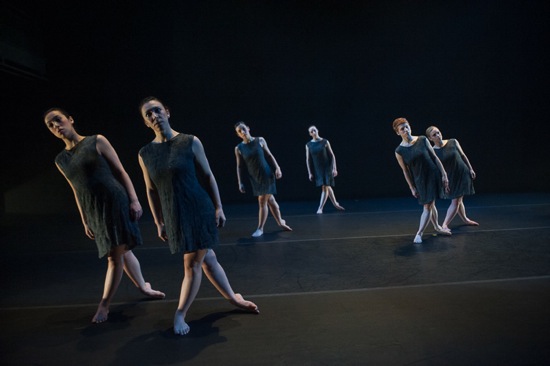
L to R: Angela Curotto, Sumi Clements, Kristin Schwab, Julie McMillan, Meg Weeks, Allie Lochary in Clements’s Shift. Photo: Christopher Duggan
What’s not to love? That is, if you—like me—are easily entranced by the combination of formal purity and weirdness. When the lights come on in the black box of the Brooklyn Academy of Music’s Fishman Space to signal the beginning of Sumi Clements’s Shift, three women stand, separated from each other and staring through us. It’s how they stand that’s interesting. They’re slanted to the side, arms pinned to their flanks, with one foot crossed behind the other and clubbed so that’s it’s resting on its outer edge. One of the women is Clements; the other two (as I remember) are Julie McMillan and Angela Curotto. They wear dark gray, sleeveless sheaths, made of a coarse material. A loud ticking begins. They seem frozen there. Three more women enter and strike the pose, then three more. The first important move is to change feet and slant the other way. Then change back.
This is the first of two premieres presented by Summation Dance, the company co-founded in 2010 by Clements and Taryn Vander Hoop (both of whom I knew as graduate students in NYU-Tisch School of the Arts). With Clements as the artistic director and chief choreographer and Vander Hoop as executive director and associate artistic director, the company, in a short time, accomplished a great deal in terms of securing funding, producing work, and developing an artistic profile.
For quite a while, Shift plays around with the image of tilted women, who are neither uncomfortable nor fully at ease in their peculiar posture. Kyle Olson’s effective score grows and changes in texture. Simon Cleveland’s lighting creates atmospheric shifts. Clements, too, gradually expands the movement possibilities. The women—all wearing Brigitte Vosse’s simple dresses—come and go come together in brief trios and duets. Vander Hoop dances alone a couple of time. But Shift isn’t about friendships forming or people having misgivings. Members of the strong, all-female company (including Kelsey Berry, Allie Lochary, Kristin Schwab, Megan Thornburg, Meg Weeks, and apprentice Tenaya Cowsill) fit themselves into patterns as if these were rotating jobs in a well-ordered community. Occasionally, some of them stop and watch others dance.
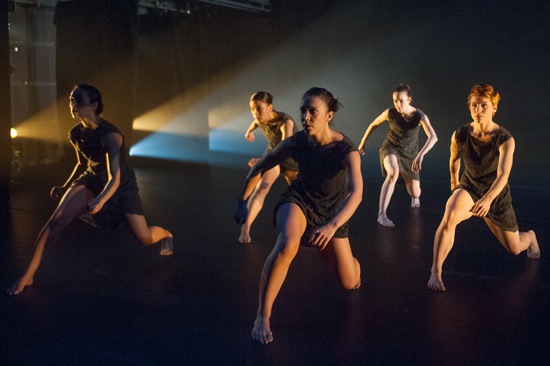
L to R: Angela Curotto, Kristin Schwab, Sumi Clements, Julie McMillan, Meg Weeks in Shift. Photo: Christopher Duggan
Clements is sparing with her well-designed movement embellishments and shifting configurations. The performers lunge, roll on the floor, run onto the stage backward, or form a tidy line and then break away from it. Aside from that narrow off-balance stance, they move big and bold; feet wide apart, knees bent, they thrust themselves into dancing. The floor is a good place to be.
At some point in the latter part of the dance, I find myself less attentive to it and am not sure why. Does its length exceed its inventiveness? Does the choreography voyage so far from its initial, fascinating images that we lose the logic of its form? Does the dancing begin to sew itself too tightly to the insistent beat that becomes prominent in the music?
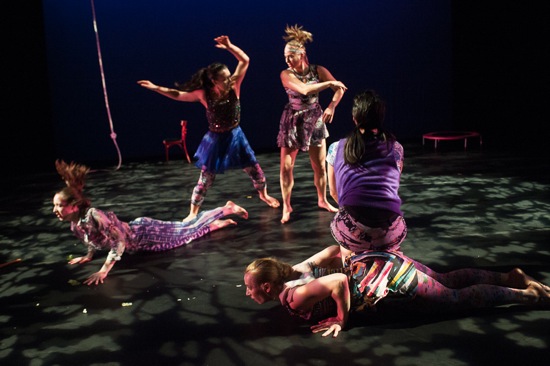
Clements’s Pathological Parenthetical Pageantry. L to R: McMillan, Clements, Lochary, Curotto seated on Vander Hoop. Photo: Christopher Duggan
I cringe at the title of Clements’ Pathological Parenthetical Pageantry, but it does convey something about the dance. If Shift is stark and precise, PPP is all about excess, mess, and glamor with its seams showing. Also about the conflicting emotions stirred up by the act of performing in public.
This time, only Clements, Curotto, Lochary, McMillan, and Vander Hoop appear onstage, garbed in imaginatively outrageous outfits by Vosse. Whatever they’re doing, or getting ready to do, it’s clear that they are not clear about what it is. In a bluish gloom, they trot around, putting things onstage, picking up tiny things that aren’t supposed to be there. Then they stand off to one side and adjust their costumes. A spotlight beams on, making an inviting pool. They eye it and fix themselves up some more. Someone gives Curotto a shove, and the five parade in and form a line facing us—very close to the front row of spectators. They breathe heavily, like wary horses, then retreat to the sidelines. They try again, and this time they back up just a bit, step stiffly with their legs wide apart, show us they can kick, and then wonder what to do next.
The music starts about now: Grammatik’s “Good Evening Mr. Hitchcock” (with the director’s unctuous British voice poking through) and “Dance Yrself Clean” by LCD Sound System. The title of this last seems appropriately inappropriate. The women definitely get dirty. In several ways. These are chorus girls from hell, each with an attitude—some snarling, some grinning crookedly, and all eager to please us. Or maybe eat us.
They run and dive to the floor. They dance like crazy, sometimes in unison. What is this all about? Do you think they know? What about that underused rope hanging at the back? They get pelted with vegetables: peppers, cauliflower, broccoli, cabbage. They squabble in dappled light. Clements crawls off and pelts them with more food. They make the best of it. As they advance bravely toward the audience, Curotto squinting around a cabbage leaf that she has draped over one eye, you don’t know whether you’d like to add a tomato or two, tell them to go home and take a bath, or applaud them heartily (the last, of course, is what you do).
Clements is a big talent, but, like Shift, although for different reasons, Pathological Parenthetical Pageantry bogs down a bit in the middle, then rights itself. She’ll figure this out, I expect, and keep pushing onward.

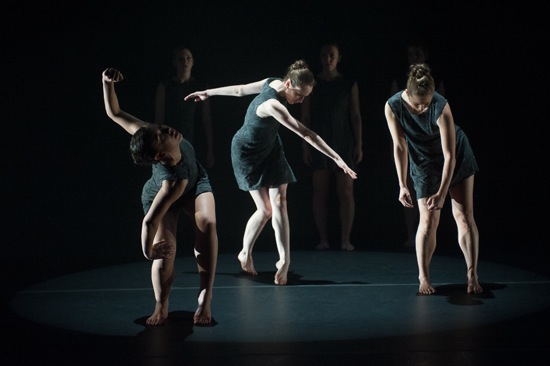
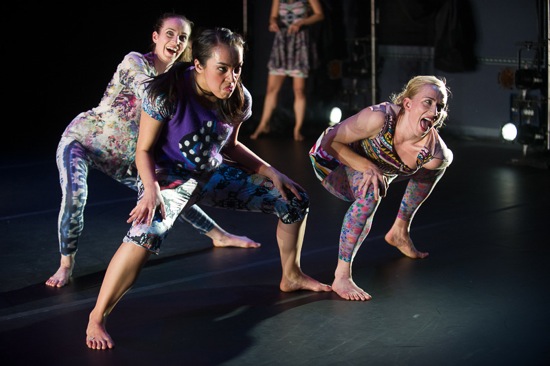
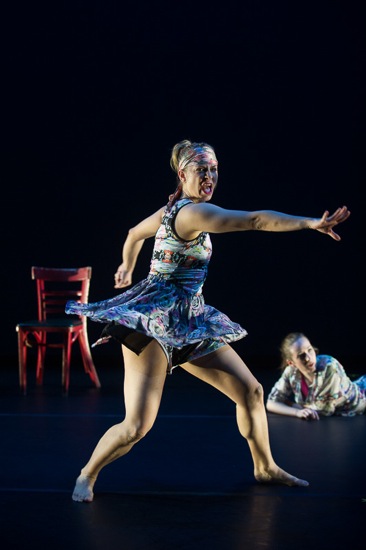
Again and always I feel drawn into the experience by your writing even though I was not physically present in the audience. This piece brings an extra pleasure in that it is written about a former student! Thank you for the triple gift of your eye, mind and pen, Deborah!
“That is, if you—like me—are easily entranced by the combination of formal purity and weirdness. ”
I’m there. Those first two images, with your description of the work, are very compelling.
I appreciate your discussion of the overall structure of the works here — it’s one thing to make some fascinating movement, and something else to find a home for it.
Like Ms. Kurtz, I’m there as well, and when I read that sentence I couldn’t help thinking of Taylor’s “Cloven Kingdom.” I suppose those words can also be applied to visual arts–Salvador Dali’s meticulously rendered drooping clocks come to mind. Thanks again Deborah, for putting us in the theater with you.